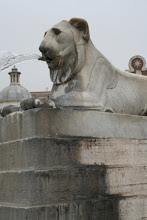It’s odd how few
travellers make their way into Lazio, the roughly-central region of Italy
(close to the kneecap, if you remember your “Italy kicked Sicily” mnemonic ),
of which Rome is the capital. People are
perhaps too intent on reaching Florence, or Siena, or the hill towns of Tuscany
and Umbria.
Anywhere from 45 mins to an hour and half around Rome are
some fascinating places to visit, including the ancient necropoli and
ampitheatres of the estruscans, the fortified hill towns of the romans, and the
mediaeval churches and basilicas of the 12th and 13th
centuries. There are inland lakes, papal
palaces, stunning open countryside and of course, fantastic food and wine.
My landlady Sari has an apartment at Lake Bolsena, one of the largest inland volcanic lakes in
Italy. She regularly travels up to Bolsena
for some respite from Rome, and this Friday we both headed off, firstly to see
the ancient Etruscan city of Tuscania and then on to spend a couple of days
relaxing at Bolsena. It was surprisingly
easy to get out of Rome (we left around midday on Friday) and after driving
past the old Olympic Stadium north of the Vatican, we took the Cassia, the old
Roman road, to Tuscania.
High on a windswept hill is the Basilica of San Pietro,
which stands on Etruscan ruins dating to a temple of the 6th century
BC. The facade of the church overlooks a
grassy area between the bishop’s Palace and the powerful defense towers. Standing in the square of the basilica, you
can look towards the (later) fortified town ofTuscania. The interior of the church is austere; most
of the frescoes have been lost, although the ceiling soars way above your head,
and the intricate rose window and marble floors are lovely. Steps lead down to the crypt, with a maze of
vaulted arches. It’s like standing in a
forest of stone columns.
Bolsena feels immediately like a place to relax. The central piazza is open and light, and the
corso, the main street, runs left and right to smaller piazzas with fountains
and cafes. The old town of weathered stone
looms up over the piazza, and you can see the fortifications of the Castello
Rocca, some hundreds of steps up above the town. And everywhere are views of the lake. Arriving at night, we see the lights of the
towns around the lake – Marta, Capodimonte and Sant’Antonio.
Sari has arranged dinner with some friends just outside
Orvieto, in a restaurant set on a country road, and the conversation is totally in Italian. After four enjoyable hours, my brain is
spinning, although everyone tries good-naturedly to speak slowly (impossible for
Italians!). There is masses of food, all
for a set price of 20 euros each, and this includes – if you can manage it –
crostini, prosciutto, salame as a starter, then two pastas (wild boar sauce,
and the other rabbit sauce), then grilled meats from the enormous fireplace in
the restaurant, and THEN desserts, vin santo wine, biscotti and coffee. It’s an incredible amount of food, and there only
seems to be one chef, a big man with an even bigger enthusiasm, exhorting
everyone to eat up and enjoy the food.
Sunday we get up late, I head up to the Castello while Sari
catches up with her work (she writes for a Rome newspaper) - I'm particularly taken with a terracotta putti in the museum of antiquities.
Later we drive
around the lake, stopping for a lunch of river fish with fennel and some dry local
sparkling wine (of which I also now have a bottle in my apartment fridge). We linger so long that the
lake changes from blue to pinks and greys, the sky begins to darken and the
two central islands are enveloped in
mist.


.jpg)
.jpg)
.jpg)
.jpg)
.jpg)


Hi Liz, sounds like a great trip, and the weather looks to have been good for you too ! As always the blog is full of information and entertaining.... wish we were there. Hope your language skills are benefitting. Cheers Chris
ReplyDeleteHi Chris, I have been really lucky with the Italian winter. Long may it continue!
ReplyDeleteLazio, as you know, is wonderful (as is Rome)
xx